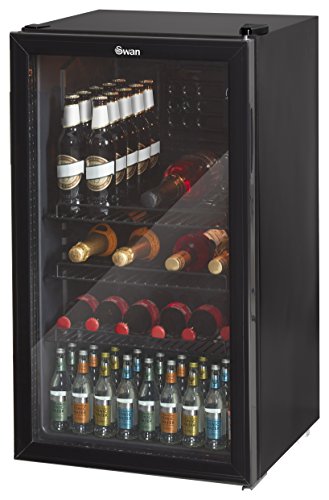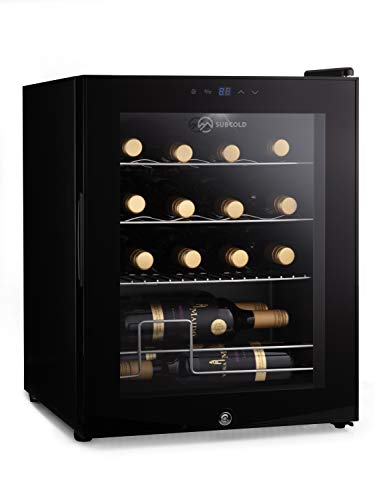You'll Never Guess This Wine Fridge Cooler's Secrets
페이지 정보
작성자 Rafaela Hinojos… 작성일 24-09-06 01:18 조회 4 댓글 0본문
 The Benefits of a Wine Fridge Cooler
The Benefits of a Wine Fridge CoolerA wine fridge cooler helps keep bottles at the right temperature for maturing and reaching their full potential. A wine refrigerator that is well-designed regulates humidity levels to stop corks from drying out and becoming oxidized.
 Choose a wine fridge commercial fridge with multiple temperature zones. This feature is ideal for those who have a wide range of wines that require different storage conditions.
Choose a wine fridge commercial fridge with multiple temperature zones. This feature is ideal for those who have a wide range of wines that require different storage conditions.Compressor-based cooling
A wine cooler utilizes compressor technology to keep your most loved wines at the ideal temperature for serving or storage. This kind of cooling system is frequent in beverage refrigerators. It gives a more uniform temperature throughout the refrigerator.
wine rack and fridge refrigerators that feature this cooling technology are available in freestanding or built-in models that allow you to easily incorporate the perfect wine storage solution to your kitchen, bar area or wine cellar. They can be mounted under counters or recessed, and in many cases, they come with front-facing ventilation, so that they be seamlessly integrated with your other kitchen appliances.
Wine refrigerators that make use of this cooling technology don't just ensure the proper temperature, but also perform other functions important for storing wines. They could, for instance, be equipped with an humidification control system that controls the air inside the refrigerator and adjusts water flow in order to ensure that the wine bottles are adequately moistened. This helps prevent oxidation, which can affect the flavor of the wine.
Certain wine coolers also come with dual or triple temperature zones to ensure that you can store different kinds of wine at the ideal temperature. This is a great option for those who enjoy both white and red wines or want their wine collection divided into various storage categories.
Another feature that is offered in some wine cooler fridge refrigerators with this cooling technology is a UV-resistant glass door, which can help protect the wine inside the bottle from the harmful ultraviolet rays that can damage the wine.
Wine refrigerators with this technology are typically quiet, and they produce no vibrations. They do not use liquid refrigeration and thus do not have moving parts which vibrate or cycle while they are operating. This helps to reduce vibrations that can lead to loose hardware connections and other issues with the internal components of the wine refrigerator cooler. This helps reduce the noise and makes your wine taste great.
Thermoelectric Cooling
Thermoelectric coolers differ in technology that is different from compressor-based units. Instead of refrigerants, thermoelectric coolers rely on Peltier effect to keep wine bottles cool. The Peltier effect occurs when an electrical current is passed through two metal pieces which are connected which causes one side to warm up while the other cools down. This difference in temperature allows the cooler to keep the cabinet cool.
In the majority of cases, a heat sink is employed to distribute cold air throughout the cabinet. It is typically a piece of aluminium that has been electrolyzed to increase its surface area and help in the dissipation of heat. The cooling process is assisted by fans that are positioned at each end of the heat sink to assist in circulation and ensure the wine stays at a consistent temperature.
A key advantage of this technology is that it is environmentally green. Thermoelectric wine fridge commercial fridges don't use any refrigerants, making them less damaging to the environment than compressor-based coolers. They are also cheaper to run and use less energy than compressor-based coolers.
It is important to remember that compressor units are more effective at keeping wine bottles at the optimal temperature than thermoelectric wine coolers. This is because they're not able to get as cold as they should be. They also require more maintenance because they are always running.
Thermoelectric wine refrigerators are quiet and environmentally friendly. They are a great option for those who wish to keep the atmosphere of their restaurant or home. They are also great for living rooms where people like to entertain guests or sip a glass of wine on their own. This is because they can be set up in any room in the house or restaurant without creating disturbance. They don't have any compressors or motors that can be noisy.
Humidity Control
Wine is sensitive to the environment and requires specific conditions to properly age. The temperature and humidity play important roles in the process, safeguarding cork integrity and preserving quality over time. A wine refrigerator maintains an optimal temperature range and regulates humidity to ensure the best ageing process.
The ideal level of humidity for storing wine is between 50 and 70 percent. If the humidity drops, there is a risk of oxidization that can develop off-flavors, which can cause the wine to lose its flavor. The excessive humidity can also be an ideal breeding ground for mold and mildew, which can damage labels and compromise the quality of the cork. Wine refrigerators create an environment that discourages mold and mildew growth, while protecting the appearance and taste of wine.
Many wine refrigerators have humidity control systems that regulate and maintain the proper humidity levels. These systems are equipped with an inbuilt hygrometer which monitors the air quality in the wine cellar and automatically adjusts humidity settings to maintain it within the desired range.
Additionally, certain wine fridges are designed with internal fans that aid in the circulation of air and stop pockets of humid or warm air from forming. This helps to maintain consistent conditions throughout the wine storage space and helps reduce energy consumption by limiting fluctuations in the fridge's operating temperature.
Additionally, the majority of wine refrigerators come with doors made of solid or dual-paned that offer insulation and protection from harmful UV rays which can destroy the wine's components and alter the flavor. Certain wine refrigerators are equipped with vibration reduction mechanisms to reduce disturbances which could disturb sediments in older bottles, or disrupt the aging process.
While passive cooling techniques can be effective in the reduction of humidity, you may need to introduce more moisture into your wine refrigerator if it has been operating under insufficient conditions for extended periods of time. In the short term, you can use moisture absorbers and air dehumidifiers that are composed of crystals or mineral salts to absorb water vapour in the air. These devices should be emptied and replaced on a regular basis. If you're looking for a long-term solution, you can install an active air humidification system that incorporates an atomizer for water and a tank of water.
Storage Capacity
If you are a regular drinker and would like to keep a few bottles on hand for unplanned or spontaneous occasions, then having a reliable wine fridge is essential. These devices recreate the optimal conditions of natural caves and cellars so that your wines can develop their fullest flavors over time.
Wine is a delicate mix of various compounds that interact to create distinct aromas and flavors. A proper storage environment will preserve these properties, and will prevent premature aging. This will rob the wine of its true essence. In a standard refrigerator changes in temperature can alter these molecules and cause the flavors to fade. In a wine fridge, humidity control and constant temperatures prevent these issues.
Wine refrigerators regulate humidity to stop corks drying out and leaking. If a wine bottle is stored in a dry environment, the labels may be removed and the wine may lose its flavor. Wine fridges keep relative humidity levels between 55% and 75 % to protect the integrity and flavor of wine bottles.
These cooling systems are often equipped with internal fans to ensure an even air flow throughout the cabinet. This prevents the formation of pockets of humid or warm air, and ensures that the collection is at a constant temperature. A lot of units include racks and shelves designed to softly and securely hold bottles. This will safeguard your bottles from damage, and let you arrange them in a way that is efficient.
Some wine refrigerators feature dual temperature zones, which are helpful for storing various types of wine at the optimal temperatures. They also come with LED lighting and doors that are UV-resistant. These features protect your wines protected from sunlight damage while also making them accessible. Certain wine refrigerators also have carbon filters that reduce the odors that emanate from the air, which can seep into the corks and affect the flavor of the wines.
When choosing a wine cooler, take into consideration how much space you have available and how extensive your collection is. The majority of wine coolers are built into cabinets or under counters, and come in a variety of sizes and shapes. Some have front venting, so they can be installed in narrower spaces. Some wine refrigerators have adjustable shelves, allowing you to accommodate oddly-shaped bottles.
댓글목록 0
등록된 댓글이 없습니다.

